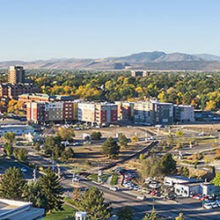- As demand for outdoor recreation increases and communities recognize its diverse economic and social benefits, many states are developing funding programs to support outdoor recreation.
- States have adopted a variety of enabling mechanisms, revenue sources, and administrative approaches.
- The strongest programs have dedicated revenue through constitutional amendment or statute; broad coalitions of support; flexibility to fund diverse geographies, communities, and project outcomes; the ability to leverage funds; and strong accountability and transparency.
- Case studies from seven states highlight different strategies and best practices.
Outdoor recreation is a powerful economic engine, generating more than $887 billion in consumer spending in the United States. It also benefits public health, quality of life, property values, and the local tax base, generating $59.2 billion in local and state tax revenue. Business owners also use access to outdoor recreation as an effective tool to recruit and keep talent.
Many states have authorized mechanisms for funding outdoor recreation, and even in an era of divisive political polarization, voters continually and strongly support measures for the outdoors. In fact, more than 80 percent of funding for recreation and conservation is generated at the state and local level. Strategies are diverse and often tied to other values such as habitat conservation, farmland preservation, and cultural heritage.
This report, produced for the Outdoor Industry Association, focuses on state funding mechanisms that support outdoor recreation, including strategies employed across the country, best practices for funding outdoor recreation at the state level, and detailed case studies of seven states: Arkansas, Colorado, Minnesota, North Carolina, Texas, Vermont, and Washington.
Summary of Strategies & Practicies
State-funded outdoor recreation requires a combination of an enabling mechanism creating the program (e.g., statute or constitutional amendment) and a revenue source (e.g., appropriations, sales tax, or bonds). The most successful, secure programs link a dedicated funding source to the program from the outset.
Enabling Mechanisms
States enable funding programs for outdoor recreation in a variety of ways, including statutes that allow general appropriations on a regular budget cycle, statutes that dedicate specific revenue, and constitutional amendments.
In general, constitutional amendments are the most secure because they confirm state commitment and make it more difficult for legislators to borrow or divert funds. Such dedicated funding, however, can result in declines in general appropriations. Some states (notably Washington) have demonstrated success with annual appropriations.
In many states with dedicated funds or constitutional amendments, revenues bypass the general fund and are deposited directly into a protected fund. Whether a true trust fund in which principal is protected and only interest is spent, or simply a separate account, these programs enjoy greater security because funds are more difficult to borrow or divert.
No single method is immune to challenges, including diversion or borrowing by the legislature, declines in general fund revenue, economic volatility, and sunset clauses that require renewal efforts.
State Recreation Funding Sources
States use a variety of revenue sources to fund outdoor recreation programs. Current state programs range from sources dispersed across all taxpayers, to revenue from a subset of taxpayers, to user-specific taxes, to unrelated business income. As described above, dedicating revenue to fund outdoor recreation is the most secure option, no matter the source.
Revenue sources dispersed across all taxpayers, such as general appropriations and sales tax, can be difficult to access because they are in direct competition with other general fund or other statewide needs. Because health, economic, and quality of life benefits of outdoor recreation extend to all residents of a state, it is logical to distribute the cost to all taxpayers. Sales tax revenue has the added value of distributing some of the burden to out-of-state visitors.
Some argue it is unfair to use revenue sources paid by only a subset of the population, such as lottery proceeds or real estate transfer taxes. The payor may carry an unfair share of the burden of paying for outdoor recreation when many others will benefit. Still, these are popular revenue sources in many states. Participating in the lottery is voluntary, and in places affected by development, real estate transfer taxes often are paid by those who may be contributing to sprawl. Many of the revenue streams in this category are vulnerable to economic downturns, resulting in funding instability during market decline.
So far, only two states—Texas and Virginia—directly tie taxes generated by users to funding outdoor recreation (see the Texas profile). In both cases, these so-called “sporting goods sales taxes” are not additional taxes on sporting goods, but rather a set-aside of existing sales tax revenue attributable to the sale of sporting goods, as estimated from market surveys.
A few states use business income from oil and gas leases or revenue on state-owned land to support outdoor recreation. The benefit of such revenue is that it does not directly increase the burden to taxpayers. However, these revenue sources are not available to all states, can introduce environmental concerns, and they are experiencing market decline in many places. Because these revenues are not possible in all states, we do not address them further in this study.
When revenue sources affect only a subset of taxpayers or are in direct competition with other interest groups, opposition may be more likely and well-organized. Campaigns—especially those that require a vote of the public—become much more difficult and expensive when there is organized opposition.
Existing Versus New Revenues
States adopt different approaches when it comes to determining whether a new revenue source or an existing revenue source can be tapped to support outdoor recreation. Carving out a portion of an existing funding source can be appealing to legislators, as it is not creating new taxes and means the burden does not increase for taxpayers, but it puts outdoor recreation directly in competition with programs that might have otherwise received that revenue. Texas and Vermont are examples of states that carved out portions of existing taxes.
Creating a new tax can be equally problematic, especially in fiscally conservative states. Unless the new tax has a sunset horizon, it can be a heavy lift. Many states opt to add onto an existing tax, such as incremental increases in sales tax or document recording fees. Arkansas and Minnesota are examples of states that increased existing taxes.
Administration and Distribution
Most statewide funding programs for outdoor recreation distribute funds to both:
• State Parks or other state agencies, and
• Local governments via matching grants.
In every state profiled here, funding is used for land acquisition and capital improvements (sometimes including renovation of existing facilities) for things such as infrastructure, trail building, and facilities. Many states also allow funding to be used for operations and maintenance, and a few allow grant funding for programming or other unique strategies.
In most states, grant programs are administered by professional staff within a state agency. Staff often provide technical assistance to local governments, helping make projects competitive and align with program criteria. This is especially important in states with rural communities that may lack professional park or recreation planners and staff. Administration of programs is sometimes within state park agencies, but some states manage the program within a separate, stand-alone department. A few states have created new Offices of Outdoor Recreation that provide political support.
Grant funding recommendations are typically made by advisory boards consisting of legislators, state agency leadership, and/or citizens appointed by the governor. States that include citizens on advisory boards generally report better success in depoliticizing funding decisions. In general, evaluation criteria established with public input help govern funding decisions.
Best Practices & Lessons Learned
No matter which mechanism or revenue source is selected, the most successful programs incorporate common themes in establishing, designing, and administering a funding program. While each state is unique and must find its own balance between the politically possible and program efficacy, the lessons described here can apply anywhere.
Cast a Wide Net
Broaden the mission beyond outdoor recreation. While inviting other interest groups to the table may seem like less of the pie for outdoor recreation, it often means a slice from a bigger pie. Incorporating other values tied to statewide quality of life—such as habitat conservation, farmland preservation, cultural heritage, arts, and affordable housing—can broaden the base of supporters, make new or expanded taxes more palatable, and build a coalition of supporters to keep the funding secure in the future. More importantly, aligning the benefits of outdoor recreation with other critical statewide needs can make the resources go further and create a bigger benefit for your state. Case studies: Arkansas, Colorado, Minnesota, Vermont.
Diversify partnerships and build coalitions. Building a strong, diverse team of advocates from nonprofits, businesses, and local communities will benefit not only the passage of the measure, but also help thwart future threats or challenges to the measure such as legislative tinkering or competition from other interest groups. Establishing strong coalitions that support the funding ensures long-term success and accountability, and can help sustain popular and political support. Case studies: Colorado, Minnesota, Washington.
Leverage threats into opportunities. Many statewide funding programs originated as a response to threats such as declining federal grants or general fund revenue, increasing development pressure, or rapidly growing populations. Timely external factors can help justify the need for a state to take action and create an opportunity to catalyze partners and deploy creative strategies. Case studies: Arkansas, Colorado, North Carolina, Vermont, Washington.
Voters become program stewards. While creating a program legislatively may be easier in some ways than a ballot initiative, voter-approved measures often enjoy longer-term stability. (They are also required in some states for some measures, such as bonds and constitutional amendments.) Voters—once educated about the program during the campaign—can become advocates and stewards. They may be more likely to monitor successes and engage in the program. They will watch to ensure funding is spent as intended, and help hold legislators accountable. Once they start enjoying the benefits of the program spending, they are also more likely to renew the measure in the future, if needed. Case studies: Colorado, Minnesota.
Address All Needs
Fund a range of opportunities. Limiting a program to fund only one type of project—such as acquisitions—hamstrings a state, especially in the face of external factors such as shifting federal funding priorities, economic volatility, and climate change. Nearly all states feel a tension between funding capital improvements and operations. Avoid prescribing percentages or dollar amounts so that the program can adapt to changing needs.
Capital acquisitions & improvements. Capital projects are the most expensive and generally the greatest area of need, especially in states with growing populations. Acquisitions should go beyond the purchase of land to include infrastructure development, renovation of existing facilities, and physical improvements to develop quality outdoor recreation venues. Case studies: Arkansas, North Carolina, Vermont, Washington.
Operations & maintenance. As states add new outdoor recreation infrastructure and as visitation increases, demand for long-term operations and maintenance can overwhelm state resources and make it hard to care for what is already acquired. New funding for operations and maintenance does not generate the same excitement and enthusiasm as new projects, but it is an ongoing, increasing need. Consider allowing some portion of funds to support operations and maintenance so that resources are stewarded in the long-term. Case studies: Colorado, Texas.
Programming & unique strategies. As the U.S. becomes more urban and more ethnically and racially diverse, the country’s needs for outdoor recreation will change. Addressing transportation, language, cultural, and educational needs helps provide opportunities for all residents to participate in outdoor recreation. Programs should allow funding to support creative approaches such as multi-generational educational programming, gear lending libraries, communications and marketing, and public transportation to recreation venues. Case studies: Colorado, Minnesota, Texas.
Incorporate demographic and geographic diversity. To create the best program for your state, engage communities of all sizes and sophistication in every county. Listen to individual community needs to understand their priorities and find ways for all communities to benefit. Identify the needs and benefits for local economies, quality of life, public health, and local capacity, in addition to statewide priorities and goals. Not only will this create the most sustainable, beneficial program, it will also garner political will from voters and legislators. Case studies: Arkansas, Minnesota, Texas, Washington.
Consider designing the program to meet unique needs, such as:
Rural or small communities. Often lacking funding capacity, these communities benefit from reduced or waived match requirements. They may also lack professional capacity and require additional technical assistance in grant writing and project design.
Metropolitan communities. Urban needs can be more expensive because of infrastructure challenges, the cost of resources, and meeting the needs of larger populations.
Vulnerable populations. Providing outdoor recreation opportunities to vulnerable populations may require different strategies such as programming, cultural and language customization, and transportation support. Allow flexibility to fund these needs.
Build Security and Leverage More
Leverage matching funds. Creating a statewide funding program for outdoor recreation that requires some form of cash match (for at least some grants) can unlock access to local and federal funds, leveraging the state investment into a greater benefit.
Locally. In many places the creation of a statewide matching fund incentivized the creation of local funding sources, such as local sales tax or bonds. Once local funding sources are developed, additional projects may be generated, furthering outdoor recreation in the area. Once committed with their own funding program, local communities may be more committed and help advocate for the statewide funding program when threatened. Case studies: Colorado, North Carolina, Washington.
Federally. Most states use their statewide funding source to match federal programs such as the Land and Water Conservation Fund (LWCF) and Recreational Trails Program (RTP), helping local communities take advantage of these federal programs. As the future of LWCF and RTP are in question, statewide funding can also help offset these declines in federal sources and create vocal advocates to continue the federal funding programs. Several states have also adopted LWCF standards for their grantmaking, streamlining the application process and eliminating the need to develop an entirely new architecture for the statewide grant program. Case studies: Arkansas, Texas.
Incentivize planning to improve projects and achieve statewide goals. Many states use funding programs to help with recreation planning at both the local and state level, and several states incentivize planning by ranking higher those projects with master plans or alignment with statewide plans. Including planning requirements can slow down the application process, but it results in better, more sustainable projects. In some places, experts in the statewide program support local programs with technical assistance, helping make projects stronger. Many states also incorporate statewide goals and priorities (for example, from the LWCF-required Statewide Comprehensive Outdoor Recreation Plan [SCORP]) into evaluation criteria to ensure that funded projects further the statewide vision for outdoor recreation. Case studies: Colorado, Minnesota, North Carolina, Washington.
Accountability and Transparency Add Stability
Measure and mark accomplishments. Whether the state funding program is perpetual or will need to be renewed, monitoring and acknowledging accomplishments helps ensure that taxpayers know what their dollars are supporting. Many states use websites, interactive maps, and searchable databases to ensure transparency about where funding has been directed, but users must seek this information. Feeding users information with on-the-ground notations, such as signage and marketing materials, makes it easy for the public to understand the direct benefit of the funding on their outdoor recreation experience. A deeper understanding of these benefits helps ensure that users will advocate for protection of the funding should it be threatened. Case studies: Colorado, Minnesota, Washington.
Go grassroots from start to finish. From the creation of the measure to program design and project prioritization, inclusion of citizens from diverse communities in the state helps ensure that projects meet the public’s expectations and needs. Citizens can be involved in advisory committees at every level of the program and help state agency staff design and administer a program that generates results on the ground. Citizen engagement also adds transparency to the decision-making so the public knows their investments are being watched by people outside legislative politics. Case studies: Washington.
Further Ideas for State Recreation Funding
While the ideas and stories captured in this report showcase what states have done so far to fund outdoor recreation, several additional options are worth noting as supplemental sources of funding, or as novel strategies that can be adapted and expanded to fund outdoor recreation at the state level. Such strategies are explored in more detail in the full report and include:
• Licenses and fees such as park entrance and campground fees, specialty license plates, specialty vehicle registration fees, hunting and fishing licenses, and special event permits;
• Philanthropic partnerships with nonprofit “friends” groups or state park foundations;
• Business and corporate partnerships, including privatization of concessions or sponsorship of specific expenditures;
• Special tax districts, such as park districts or business improvement districts;
• Economic development strategies, including redevelopment projects and the sale of tax credits; and
• Natural resource trust funds from severance taxes on natural resource extraction.
Conclusion
States take diverse approaches to developing funding programs for outdoor recreation, and much can be learned from successful state programs such as the seven profiled here. Any design is subject to challenges, but the strongest programs tend to have:
• Dedicated revenue through constitutional amendment or statute;
• Broad coalitions of support;
• Flexibility to fund diverse geographies, community types, and project outcomes;
• The ability to leverage funds and statewide goals; and
• Strong public engagement and accountability throughout the process.




